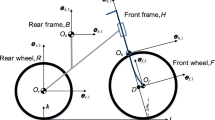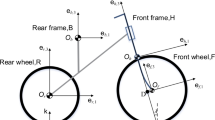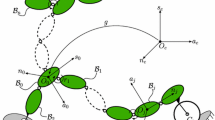Abstract
Finding out the relative equilibria and analyzing their stability is of great significance for revealing the intrinsic characteristics of mechanical system and developing effective controllers to improve system performance. In this paper, we study the symmetry and relative equilibria of a bicycle system moving on a surface of revolution. We notice that the symmetry group existing in the bicycle configuration description is a three-dimensional Abelian Lie group, and the rolling condition of the two wheels produces four time-invariant first-order linear constraints on the bicycle system. Therefore, the bicycle dynamics can be classified as a general Voronets system in which the Lagrangian and constraint distribution remain unchanged under the action of the symmetry group. Applying the Voronets equations to bicycle dynamics modeling, we obtain a seven-dimensional reduced dynamic system on the reduced constraint space. Theoretical analysis for the reduced dynamic system shows that it has the properties of time-reversal and lateral symmetries. In addition, two types of relative equilibrium points, the static equilibria and the dynamic equilibria, exist. Further theoretical analysis shows that the two kinds of relative equilibria both form one-parameter solution families, and the Jacobian matrix at an equilibrium point has some specific properties that support the relevant stability analysis. The necessary condition responsible for a stable static equilibrium point is that all the eigenvalues of the Jacobian matrix at the equilibrium point must lie on the imaginary axis of the complex plane. Due to the existence of zero eigenvalues of the Jacobian matrix, the stability of the dynamic equilibria is studied by limiting the reduced dynamic system to an invariant manifold based on the conservation of system energy. We prove in a strict mathematical sense that the dynamic equilibria may be Lyapunov stable, but cannot be asymptotically stable. Finally, symbolic computation combined with Whipple bicycle benchmark parameters was used for numerical simulations. We then use our numerical simulation to study how the parameter of the surface of revolution affects the relative equilibrium solution and its stability.










Similar content being viewed by others
Data Availability Statement
The datasets generated and analyzed during the current study are not publicly available since the authors need to do further research on them, but are available from the corresponding author on reasonable request.
Notes
In the following paragraph, a single term containing repeated indices (no more than twice) always implies summation of that term over all the values of the index.
References
Carvallo, E.: Théorie du movement du monocycle, part 2: Théorie de la bicyclette. J. Ec. Polytech. Paris 6, 1–118 (1901)
Whipple, F.J.W.: The stability of the motion of a bicycle. Q. J Pure Appl Math. 30(120), 312–348 (1899)
Boussinesq, J.: Aperçu sur la théorie de la bicyclette. J. de Mathématiques Pures et Appliquées 5, 117–136 (1899)
Klein, F., Sommerfeld, A.: Über die theorie des kreisels. Number 2–3. BG Teubner (1898)
Timoshenko, S.P., Young, D.H.: Advanced Dynamics. McGraw-Hill, New York (1948)
Sharp, R.S.: The stability and control of motorcycles. J. Mech. Eng Sci. 13(5), 316–329 (1971)
Psiaki, M.L.: Bicycle stability: a mathematical and numerical analysis. undergradute thesis. Physics Dept. Princeton University, NJ (1979)
Nemark, J.I., Fufaev, N.A.: Dynamics of Nonholonomic Systems. American Mathematical Society, Providence, RI (1972)
Hand, R. S.: Comparisons and stability analysis of linearized equations of motion for a basic bicycle model. Master’s thesis, Cornell University (1988)
Papadopoulos, J. M.: Bicycle steering dynamics and self-stability: a summary report on work in progress. Cornell Bicycle Research Project, Cornell University, Ithaca, NY (1987)
Meijaard, J. P., Papadopoulos, J. M., Ruina, A., Schwab, A. L.: Linearized dynamics equations for the balance and steer of a bicycle: a benchmark and review. Proceedings of the Royal society A: mathematical, physical and engineering sciences, 463(2084):1955–1982 (2007)
Basu-Mandal, P., Chatterjee, A., Papadopoulos, J. M.: Hands-free circular motions of a benchmark bicycle. Proceedings of the Royal Society A: Mathematical, Physical and Engineering Sciences 463(2084), 1983–2003 (2007)
Kooijman, J.D.G., Meijaard, J.P., Papadopoulos, J.M., Ruina, A., Schwab, Arend L.: A bicycle can be self-stable without gyroscopic or caster effects. Science 332(6027), 339–342 (2011)
Peterson, D.L., Gede, G., Hubbard, M.: Symbolic linearization of equations of motion of constrained multibody systems. Multibody Syst. Dyn. 33(2), 143–161 (2015)
Getz, N. H., Marsden, J. E.: Control for an autonomous bicycle. In Proceedings of 1995 IEEE International Conference on Robotics and Automation, volume 2, pages 1397–1402. IEEE (1995)
Koon, W.S., Marsden, J.E.: The Hamiltonian and Lagrangian approaches to the dynamics of nonholonomic systems. Rep. Math. Phys. 40(1), 21–62 (1997)
Boyer, F., Porez, M., Mauny, J.: Reduced dynamics of the non-holonomic Whipple bicycle. J. Nonlinear Sci. 28(3), 943–983 (2018)
Aström, K.J., Murray, R.M.: Feedback systems: an introduction for scientists and engineers. Princeton University Press, New Jersey (2010)
Baquero-Suárez, M., Cortés-Romero, J., Arcos-Legarda, J., Coral-Enriquez, H.: A robust two-stage active disturbance rejection control for the stabilization of a riderless bicycle. Multibody Syst. Dyn. 45(1), 7–35 (2019)
Moore, J. K.: Human control of a bicycle. University of California, Davis Davis, CA (2012)
Kooijman, J.D.G., Schwab, A.L.: A review on bicycle and motorcycle rider control with a perspective on handling qualities. Veh. Syst. Dyn. 51(11), 1722–1764 (2013)
Schwab, A.L., Meijaard, J.P.: A review on bicycle dynamics and rider control. Veh. Syst. Dyn. 51(7), 1059–1090 (2013)
Chen, Bin: Analytical Dynamics. Peking University, Beijing(in Chinese) (2012)
Xiong, J., Wang, N., Liu, C.: Stability analysis for the Whipple bicycle dynamics. Multibody Syst. Dyn. 48(3), 311–335 (2020a)
Xiong, J., Wang, N., Liu, C.: Bicycle dynamics and its circular solution on a revolution surface. Acta Mechanica Sinica 36(1), 220–233 (2020b)
Bloch, A.M., Krishnaprasad, P.S., Marsden, J.E., Murray, R.M.: Nonholonomic mechanical systems with symmetry. Archive Ration. Mech. Anal. 136(1), 21–99 (1996)
Bloch, A.M.: Nonholonomic Mechanics and Control. Springer, New York (2015)
Karapetian, A.V.: On the problem of steady motions stability of nonholonomic systems. J. Appl. Math. Mech. 44(3), 295–300 (1980)
Karapetian, A.V.: On permanent rotations of a heavy solid body on an absolutely rough horizontal plane. J. Appl. Math. Mech. 45(5), 604–608 (1981)
Zhao, Z., Liu, C.: Contact constraints and dynamical equations in Lagrangian systems. Multibody Syst. Dyn. 38(1), 77–99 (2016)
Peterson, D., Hubbard, M.: Analysis of the holonomic constraint in the Whipple bicycle model (p267). In The Engineering of Sport 7, vol. 2, pp. 623–631. Springer, Paris (2008)
Peterson, D. L.: Bicycle dynamics: modelling and experimental validation. PhD thesis, University of California, Davis (2013)
Wang, E.X., Zou, J., Xue, G., Liu, Y., Li, Y., Fan, Q.: Development of efficient nonlinear benchmark bicycle dynamics for control applications. IEEE Transactions Intell. Transport. Syst. 16(4), 2236–2246 (2015)
Boyer, Frédéric., Belkhiri, Ayman: Reduced locomotion dynamics with passive internal dofs: application to nonholonomic and soft robotics. IEEE Transactions Robotics 30(3), 578–592 (2014)
Strogatz, Steven H.: Nonlinear Dynamics and Chaos with Student Solutions Manual: With Applications to Physics, Biology, Chemistry, and Engineering. CRC Press, USA (2018)
Pappalardo, C.M., Lettieri, A., Guida, D.: Stability analysis of rigid multibody mechanical systems with holonomic and nonholonomic constraints. Archive Appl. Mech. 90, 1961–2005 (2020)
García-Agúndez, A., García-Vallejo, D., Freire, E.: Linearization approaches for general multibody systems validated through stability analysis of a benchmark bicycle model. Nonlinear Dyn. 103, 557–580 (2021)
Karapetian, A.V.: On the stability of steady motions of Chaplygins nonholonomic systems. J. Appl. Math. Mech. 42(5), 863–870 (1978)
Zenkov, D. V.: Integrability and stability of nonholonomic systems. The Ohio State University (1998). (PhD thesis)
Marsden, J.E., Ratiu, T.S.: Introduction to Mechanics and Symmetry: a Basic Exposition of Classical Mechanical Systems, vol. 17. Springer, New York (2013)
Khalil, H.: Nonlinear Systems, 3rd. Prentice Hall, Upper Saddle River, New Jersey (2002)
Acknowledgements
This work has been supported by the National Natural Science Foundation of China (NSFC:11932001).
Author information
Authors and Affiliations
Corresponding author
Ethics declarations
Conflict of interest.
The authors declare that they have no conflict of interest concerning the publication of this manuscript.
Additional information
Publisher's Note
Springer Nature remains neutral with regard to jurisdictional claims in published maps and institutional affiliations.
Rights and permissions
About this article
Cite this article
Xiong, J., Liu, C. Symmetry and relative equilibria of a bicycle system moving on a surface of revolution. Nonlinear Dyn 106, 2859–2878 (2021). https://doi.org/10.1007/s11071-021-06950-x
Received:
Accepted:
Published:
Issue Date:
DOI: https://doi.org/10.1007/s11071-021-06950-x




